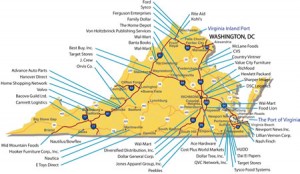 By Peter Galuszka
By Peter Galuszka
Many years ago – 37 years to be precise – I stood in the fancy dining room of a blocky-looking Japanese cargo ship and drank a toast to the captain with his Suntory scotch. The ship was docked at Portsmouth Marine Terminals, part of the Virginia Port Authority, and it was an inaugural event. The vessel was new for its time and was designed to carry Japanese compact cars that could easy be rolled on and off the ship when it reached its destination on the far side of the world.
Therein lies the rub. The VPA is in the midst of a lengthy crisis. Gov. Robert F. McDonnell fired all but one of the VPA board members about a year ago. Many were Democratic appointees, and he kept on one man. He is the former chairman of Alpha Natural Resources, the state’s largest coal firm and one of the biggest bankrollers of Republican candidates in the Old Dominion, having doled out about $1 million in recent years.
Now McDonnell, led by his Transportation Secretary Sean Connaughton, is pushing forward with efforts to privatize the VPA. Connaughton , a former Coast Guard and Navy officer and former head of the Federal Maritime Administration, knows a thing or two about ships and cargoes which makes him uniquely qualified for such endeavors. But his claims that state’s role in helping finance the VPA is “financially unsustainable” are hard to follow and justify.
It is not clear why the rush to sell off the VPA, which like all American ports, has faced some lean years with the Great Recession. Several firms, including shipping giant APM, are interested in buying the VPA and its facilities, although Carlyle Group, a private equity firm filled with Washington insiders and with no special expertise in shipping, recently dropped out.
What bothers me is not the intricacies of the proposed privatizing plans which have been less-than-transparent so far. Even Atty. Gen Ken Cuccinelli has problems with the way this is all being handled, that is, by the executive branch of state government. Another issue is that Connaughton claims that the VPA has not recovered fast enough from the recession when compared to much larger ports of New York/New Jersey and Savannah, which isn’t exactly a fair comparison.
I’ll save the privatization deal for another time. What, then, is wrong with the Port of Hampton Roads? It seems to have so much going for it. Its 50-foot deep harbor does not need dredging to handle deeper draft ships once the Panama Canal is widened. President Obama is already rushing aid to ports including Charleston, Jacksonville, Miami, New York and Savannah to dig out the muck and silt and make the channels deeper. Hampton Roads also is seemingly well-located right smack on the edge of the Mid-Atlantic with decent rail facilities, albeit trouble for trucks.
Perhaps the best analysis I have seen comes from a nearly year-old Baltimore Sun article. The piece suggests there’s nothing inherently wrong with the VPA or Hampton Roads. The only possible criticism seems to be that it made some strategic decisions some years ago that may have made sense then but got bypass by current trends.
Take the Japanese cargo ship. Hampton Roads never really exploited its ability to import cars the way much-smaller Baltimore or much bigger Long Beach-Los Angeles have. Over the next three decades after my visit to the Japanese ship, the Virginia ports pretty much kept to one model and one model only:
They exported coal, especially coking coal, the way they have for decades. And they decided to become a TEU container import play to bring in boxes loaded with consumer goods from places like China to be sold in WalMarts, Target, QVC and the like.
This made sense about 10 years ago when Americans couldn’t buy enough cheap Chinese goods and had the money to do so. Virginia’s economic planners dotted the landscape with huge fulfillment centers linked to the container trade, banking that trucks would whisk the toasters, wide screen TVs and flip flops anywhere east of the Mississippi.
Baltimore’s planners decided upon a different course. They tailored the port’s trade to bulkier goods such as autos, farm gear and construction machines, the Sun says. Another advantage is that Baltimore, long a trade wallflower, is actually closer to a big regional market that stretches from the DC area to Pittsburgh and Cleveland. That used to be known as the Rust Belt but not anymore.
As Americans still have not gotten back in the habit of buying Chinese junk, a renaissance has been occurring in that very Rust Belt and believe it or not, under Obama. The American auto industry has made a roaring comeback and exports are robust. Ditto other forms of machinery. Obama actually emphasized the creation of new manufacturing jobs as a way the country should go in last night’s Hofstra debate. He is right.
Hampton Roads, by contrast, is not as close to any regional market of comparable size. Sorry, Norfolk and Richmond are too small time. Sure there’s the coal market but that’s off kilter at the moment and Norfolk Southern has spent hundreds of millions trying to expedite train shipments from Hampton Roads to the Midwest.
But plenty of ports do that. Savannah, which burst on the scene a couple of decades ago with aggressive expansion, serves a much bigger Deep South market. Its TEU container shipments are more than double Hampton Roads. In dollar volume of cargo, Hampton Roads ranks a surprisingly lame ninth place in the U.S.
Thus, outside of coal, Hampton Roads doesn’t have any strategic advantage. It is just another container port. It is not clear how any privatization by the McDonnell-Connaughton crowd will change that. Why couldn’t the current VPA management follow Baltimore’s example? Or is this just privatization for privatization’s sake?


